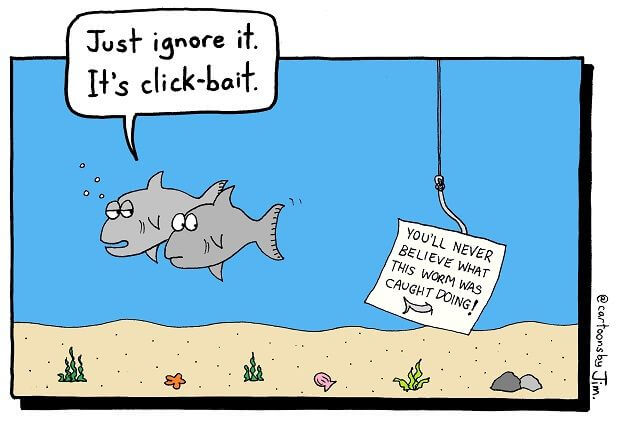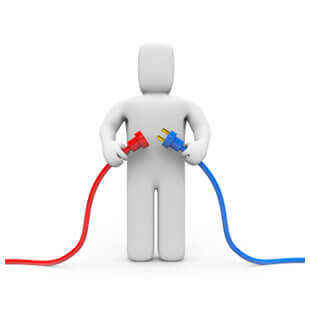Thanks, largely in part to smartphones, today’s online audience can only muster approximately 8 seconds-worth of coherent thought before becoming distracted or bored. That’s a shorter attention span than a goldfish. Thus, many online marketers resort to creative headlines as a means to generate increased traffic to an article, blog post, or other piece of online content. However, creating catchy headlines can often do more damage than good when trying to establish brand loyalty and increase consumer engagement.

Prevalence of Clickbait
What is ‘clickbait’?
Clickbait is any headline or phrase that marketers and/or publishers employ to entice viewers to click. Content marketers often employ clickbait tactics in a number of ways, such as:
- Catchy e-mail headlines
- Blog titles
- Sponsored posts on social networking sites
- Banner Ads
- Memes
- And more
Why does clickbait exist?
The increasing prevalence of clickbait is due, in part, to the fact that there is more content on the Internet competing for our attention. Therefore, to stand out, marketers will sometimes resort to creating sensationalized titles that grab our attention and pique our interest – enough to make us want to click to find out more. However, the end result is often a title that is better than the actual article. Underwhelmed by whatever content they’ve been tricked into viewing, consumers become turned off and may lose trust in that brand.
Examples of Clickbait Titles:
- “You’ll Never Believe This!”
- “What Every Budding Entrepreneur Needs to Know”
- “You’ll Never Guess Why..”
- “Shocking Results…”
- “The 5 Things You’ve Been Doing Wrong..”
Creating Content that ‘Clicks’
Instead, what content marketers should be focused on is finding a balance: Produce a title that attracts viewers. Create engaging content that encourages customers to share it with others while also motivating them to explore other content on your site. To do this, marketers need to shift away from focusing primarily on clicks. Rather, the focus should be on overall engagement and sentiment. According to a recent article, published by Marguerite McNeal: [source: https://www.ama.org/publications/MarketingInsights/Pages/one-writer-explored-the-marketing-science-behind-clickbait.aspx]
While ad revenue might be the end goal for some media companies, content marketers publish stories to engage potential customers. Their aim is to boost brand awareness and draw audiences into the funnel, and a cheap click that doesn’t deliver on its promise won’t keep a customer around for long.
Your headline and content should work in tandem. That said, quality content will always trump any yellow journalism-style approach. Give readers something that goes beyond a creative headline. Deliver an online content experience that aims to inform, educate, or inspire viewers.
 Resonant Content
Resonant Content
Content marketers can create resonant content in a number of ways. Corey Eridon, of HubSpot, offers five examples of how to achieve this:
#1 – Use images.
Images can be a powerful tool to help convey a range of emotions or ideas. They can be used to draw in a reader, and images can also offer SEO value for better searchability.
#2 – Use data.
Well-researched information is made more credible when you actually produce data to back it up. From citing sources to using an infographic, data can provide a better framework for what you are trying to explain to consumers.
#3 – Use your audience.
Pose a general question about a topic to your Twitter followers. Collect some of the responses, and include this information in your next piece of online content. Your audience’s feedback can be valuable in more ways than one.
#4 – Use real-life examples.
Real-life examples can help others understand an otherwise difficult concept. It can also serve to reinforce brand loyalty as well as introduce new customers to your brand. Why? Real-life examples allow us to relate to what is going on.
#5 – Use the right tone.
Content writers have the sometimes difficult task of nailing down what tone to use – something that varies according to what audience is being addressed. For example, you wouldn’t use SMS-speak in an article addressing corporate executives. How you structure sentences, your use of humor, grammar, and even the way you format your text, can have a tremendous impact on how your content resonates with a particular group of people.

Mind Over Metrics: Shifting Your Focus to What Matters
Learn to look beyond the clicks, and shift focus into metrics that offer feedback on how your content is being perceived by those who view it. Metrics to consider:
- # of Shares – Did the content inspire others to share it ?
- # of Comments – Did your content cause others to voice their opinion(s)?
- Sentiment among comments – What trending emotion do you see? (happiness, sadness, anger, relief, etc.)
- Post reach – How many people did your post reach?
This type of feedback can prove invaluable to a content marketer (as well as to an organization) as it allows content marketers to refine their content to better suit their target audience.
At C0MPLÉX1, we are expert content marketers; we produce quality content that appeals to our clients’ target audiences while delivering tangible SEO-valued results. Contact us today at 919-926-8733 to see how we can help your business succeed.




 Resonant Content
Resonant Content
